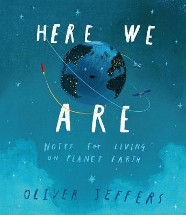Here we are: Notes for living on planet Earth by Oliver Jeffers

HarperCollins, 2017. ISBN 9780008266165
"Well, hello.
And welcome to this Planet.
We call it Earth.
Our world can be a bewildering place, especially if you've only just
got here. Your head will be filled with questions, so let's explore
what makes our planet and how we live on it. From land and sky, to
people and time, these notes can be your guide and start you on your
journey. And you'll figure lots of things out for yourself. Just
remember to leave notes for everyone else. Some things about our
planet are pretty complicated, but things can be simple, too: you've
just got to be kind."
Written for his baby son, Jeffers tries to offer an explanation of
this planet and how it works so that young Harland (and any other
little children) will be able to negotiate it successfully. Even
though this planet is a complex place, Jeffers manages to extract
its essential elements - there are basically two parts, the land and
the sea - and using direct narrative, his iconic illustrations and
simple labels he explores the concepts of the planet and the people
and animals who inhabit it. Huge ideas reduced to simple but
carefully chosen words that convey both explanation and advice.
"People come in many shapes, sizes and colours. We may all look
different, act differently and sound different... but don't
be fooled, we are all people."
Throughout there is the underlying message of choosing to be kind and
gentle to the land, its people and all its inhabitants, underpinned
by a quote from J.
M. Barrie; as part of the dedication page.
With so much emphasis on the environment in our school curricula
these days, this is the perfect book to create a child's awareness
of their surroundings beyond their immediate self. But there are so
many avenues that could be explored by posing questions such as "Is
there more land that sea?" or "If most of the land is at the top of
the planet, why doesn't the planet roll?" that could lead to
investigations by all ages.
Here we are: Notes for living on planet Earth was the No. 1
New York Times Bestseller and voted No. TIME Best Book of the Year
for 2017. It's easy to see why. A must-have in your collection and
one to be recommended to teachers as the staple that underpins all
their lessons this year.
Barbara Braxton